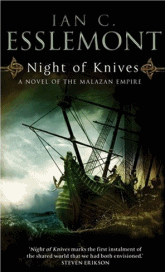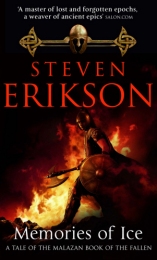Some pretty books arrived today. Hooray.






The Name of the Wind – Patrick Rothfuss.
If you look back at the blog you can see I already purchased a copy of the book. The luscious and huge UK trade paperback with a pretty cover. But then I actually prefer reading the smaller, tightly written editions, so decided to get the mass market US version as well. The fact that the huge UK version was written so big was tricky and made me believe the book wasn’t so long. The US version is really tightly written, with a small typeset, and still takes 720 pages. It is indeed one huge book.
I like this US MM version too. The map, though, is rather ugly and much worse than the classic-looking ink version that I have on the UK one. The rest is good. The new, darker cover is surely much, much better than the old US ones, and I like the plastic material they used for the cover: you can open the book easily without creasing it.
I’m in no rush to read it. The next has been delayed to next year, so I can give priority to others.
A Feast for Crows – George RR Martin.
I skimmed a lot through the books but still need to read one from back to back. Will do it later. Since I have already the other three books, I got this one too. For “Dance” I’ll wait for the MM edition to come out. No rush. I’m a bit skeptic about the writer’s true will to end the series (lack of self-discipline, some would say. He should meet Erikson). The fourth book wasn’t so warmly received as the others and the fifth was supposed to be ready years ago. Without a change of pacing I fear not much can be saved and I already read that some prefer to consider it a trilogy. It will be interesting to observe the reaction to the fifth book.
There’s an interesting thread here. But really, the more he gets swamped in the minutiae and perfectionism the worse the books will actually be. I’m pretty sure of this. He needs to find the momentum, not to revise the same page 100 times.
Memories of Ice – Steven Erikson.
Well, this is pure Erikson fetish. I already have the book, and still wanted the US, ugly, MM edition. I don’t think the artist who made the cover(s) is a bad one, but he’s really out of style with Erikson. Looks like a spin-off of Forgotten Realms and it can’t give a wronger impression (and despite the US cover is actually more pertinent to the story). 900 pages, one of the longer books in the series, the best for most of the readers. Those 900 pages are actually on the short side as the typeset used is as tiny as possible and there’s not even spacing between chapters. So, outside the fetish, the UK editions are much, much superior.
Legend – David Gemmell.
Going back in the years. I never read Gemmell and I’m more interested in this long series than semi historical fiction he wrote. 350 pages, this should be quick to read compared to the epic sized things I’m reading lately.
A Cavern of Black Ice – J. V. Jones.
If it wasn’t clear, I prefer to get into living writers who are productive and that I can look forward in an ongoing way. I actually enjoy the wait and hype in the sense of the community, frequenting forums, discovering new authors and so on. Much more than digging on the past, on which there are less interesting things to say.
I think this series started as a trilogy then blended into a “pentalogy”. Third book came out last October after a long wait. I think she’s trying to rival Martin (in time elapsed between books). On the other side I read the series is good, rather complex, with lots of characters and multiple POV. Yeah, I don’t know a whole lot, but between all the books I have on the to-read list, this one makes me curious and the one I’m the most eager to read. 770 pages, this also a rather big book.
And, drumroll….
Wizard’s First Rule – Terry Goodkind.
I said I was going to buy it, and I did. Got the new Tor edition with the stone bridge on the cover. 820 pages, surprisingly thin on quotes and praises ;)
Oh, and I actually plan to read it, probably soon.
I’m 300 pages from the end of Deadhouse Gates and while I expect to follow with Memories of Ice, I’d still put some other book in between. I definitely need a break or risk exhaustion, so I need something lighter and easier to read while I recover. I’m wondering what. It could be either J. V. Jones or Goodkind, but both are big books and I may decide for book 3 of the Black Company (Glen Cook) or Gemmell as they are shorter. On the other hand I prefer to read something entirely new so it could really be Goodkind or J. V. Jones. Or even go back to Jordan and read the third book. Undecided.
And there are also Scott Bakker and Abercrombie to consider. And Donaldson Gap series. And Keyes.
(I’ll probably read a bunch of prologues and then decide for the stickier)
 One downside of reading Steven Erikson is that I don’t have anymore the excitement and curiosity of what to read next, as I have a (growing) pile of books still to read and I know it’s better that I don’t let pass time between each to not risk getting lost and enjoy all the details and layers.
One downside of reading Steven Erikson is that I don’t have anymore the excitement and curiosity of what to read next, as I have a (growing) pile of books still to read and I know it’s better that I don’t let pass time between each to not risk getting lost and enjoy all the details and layers.


 I’ll start quoting
I’ll start quoting  This book wasn’t part of my reading queue, but my dad bought it and I decided to read it as well as it is rather short with its 200 pages written large.
This book wasn’t part of my reading queue, but my dad bought it and I decided to read it as well as it is rather short with its 200 pages written large.

